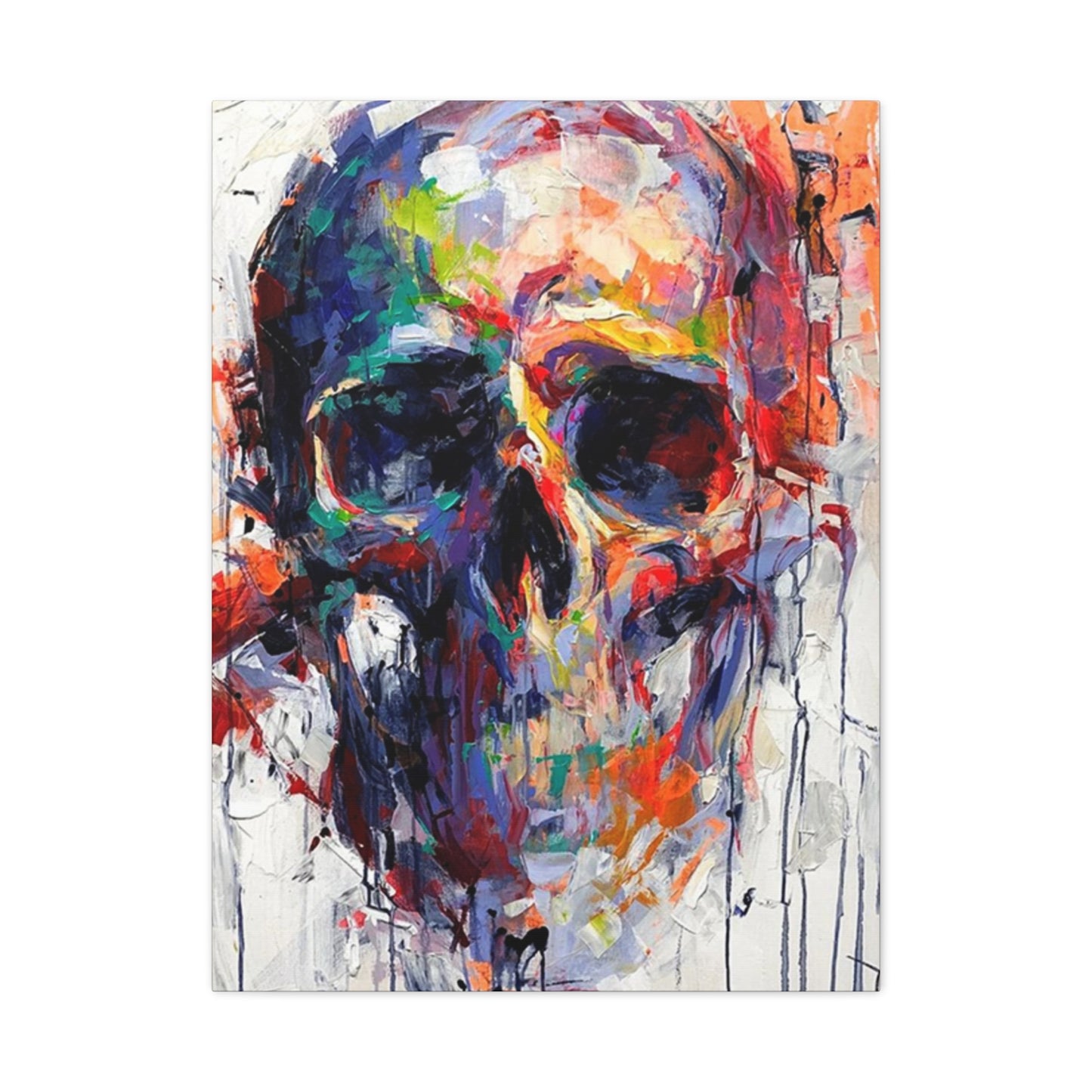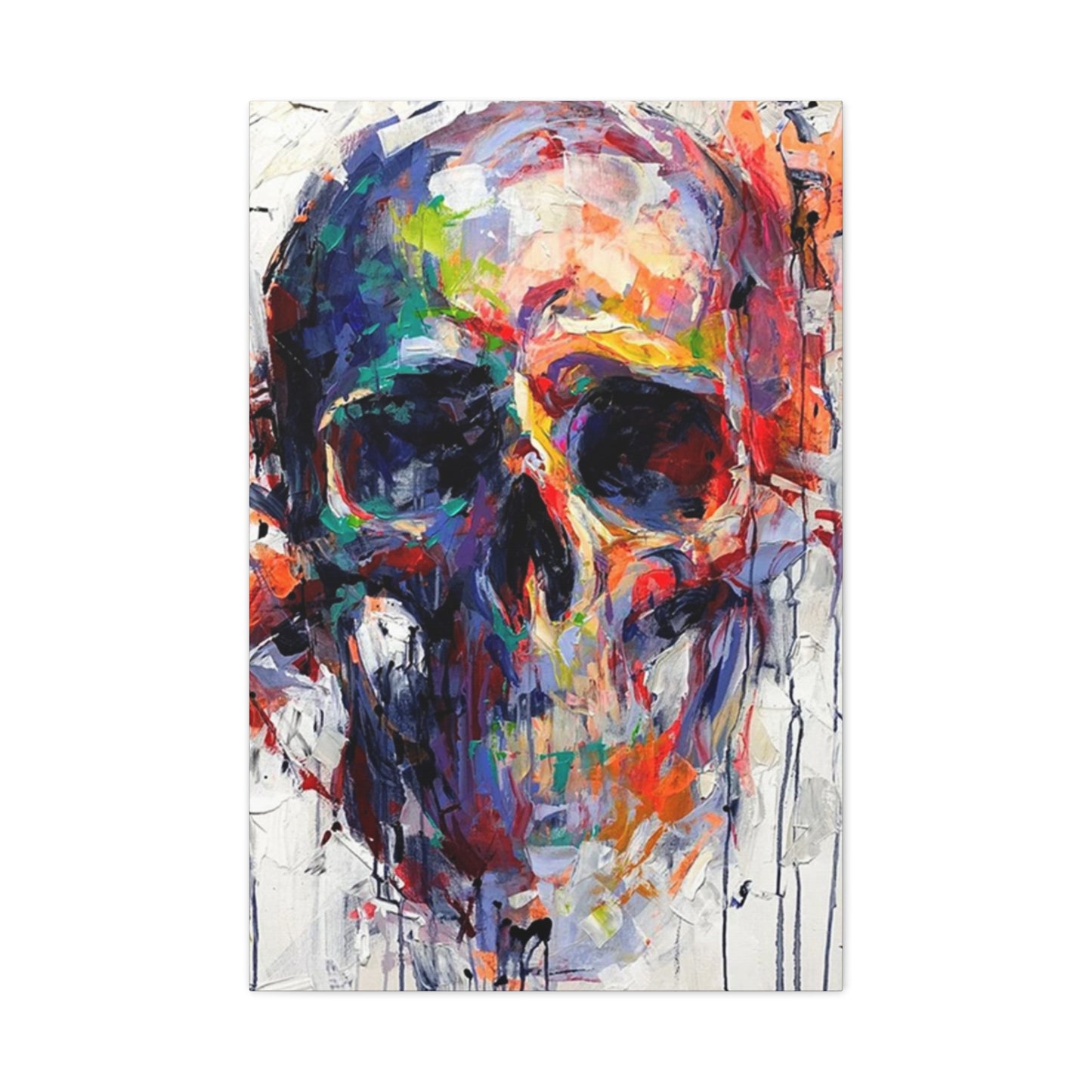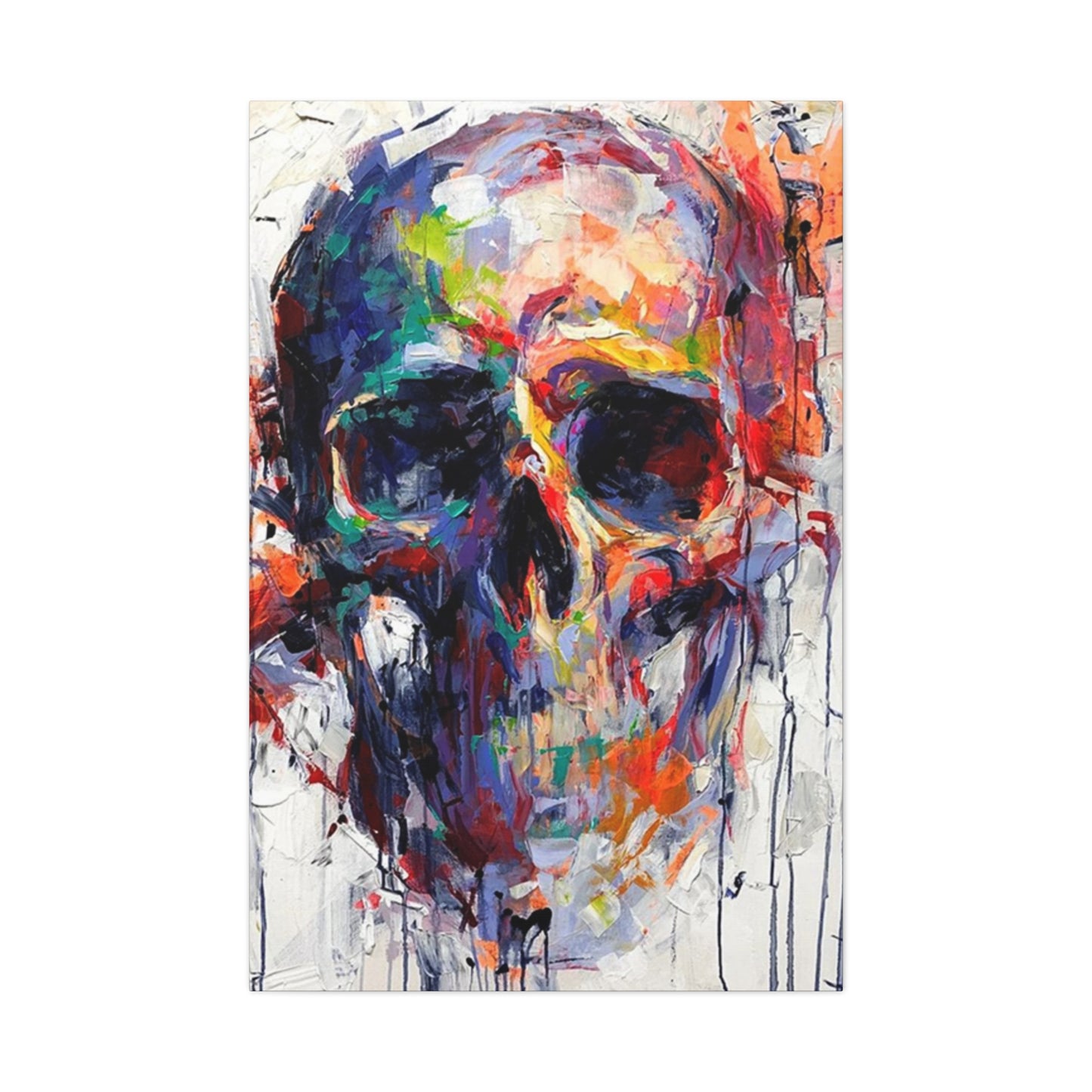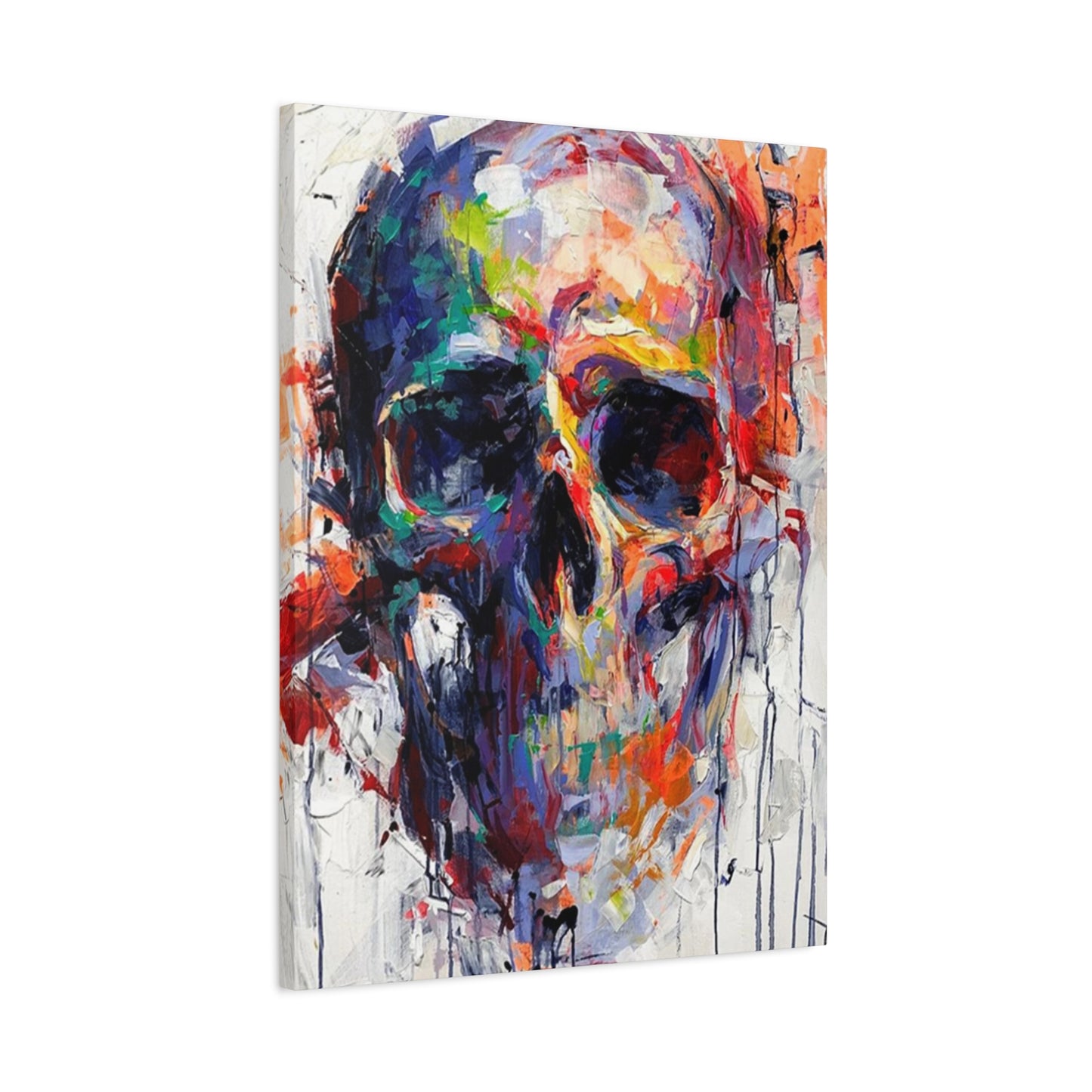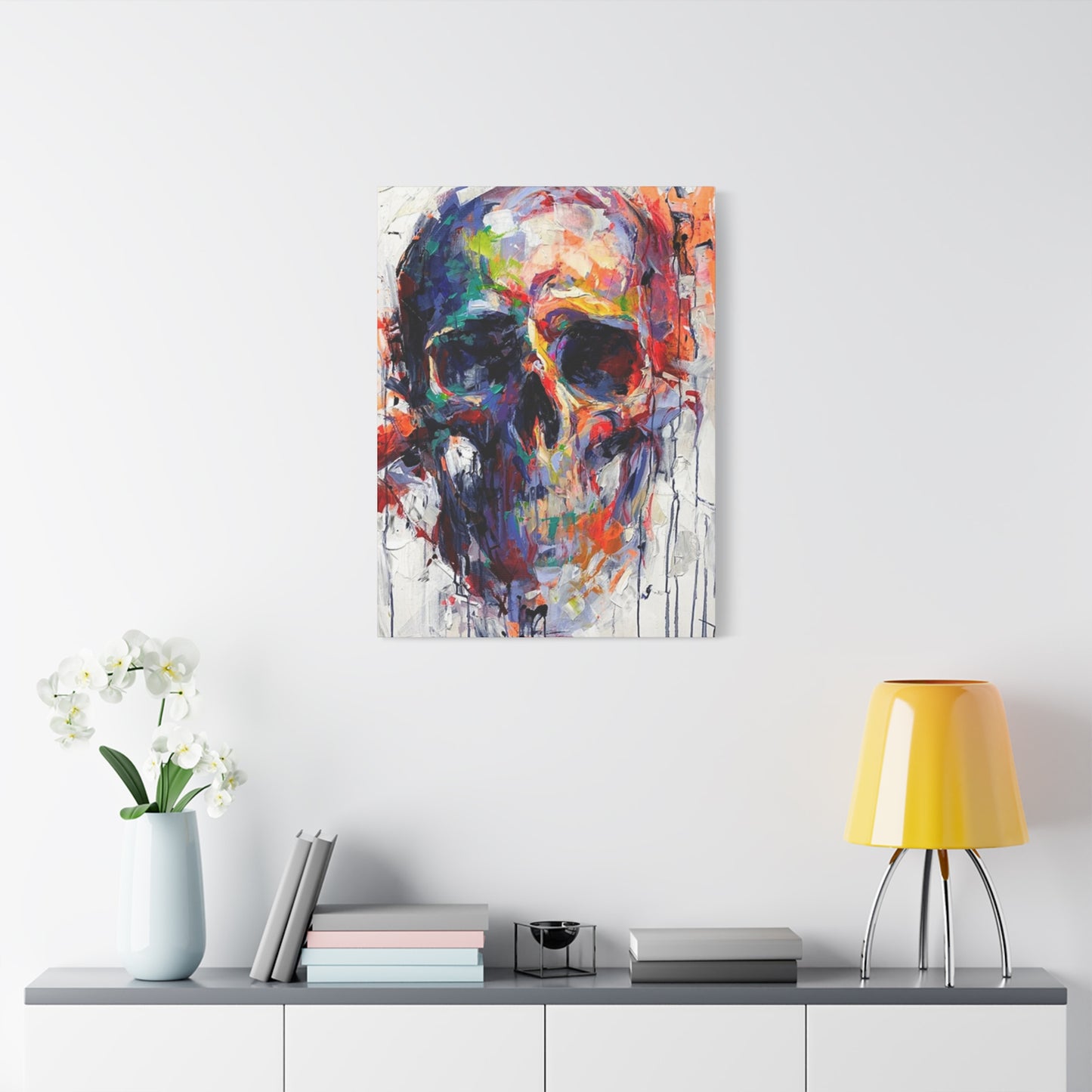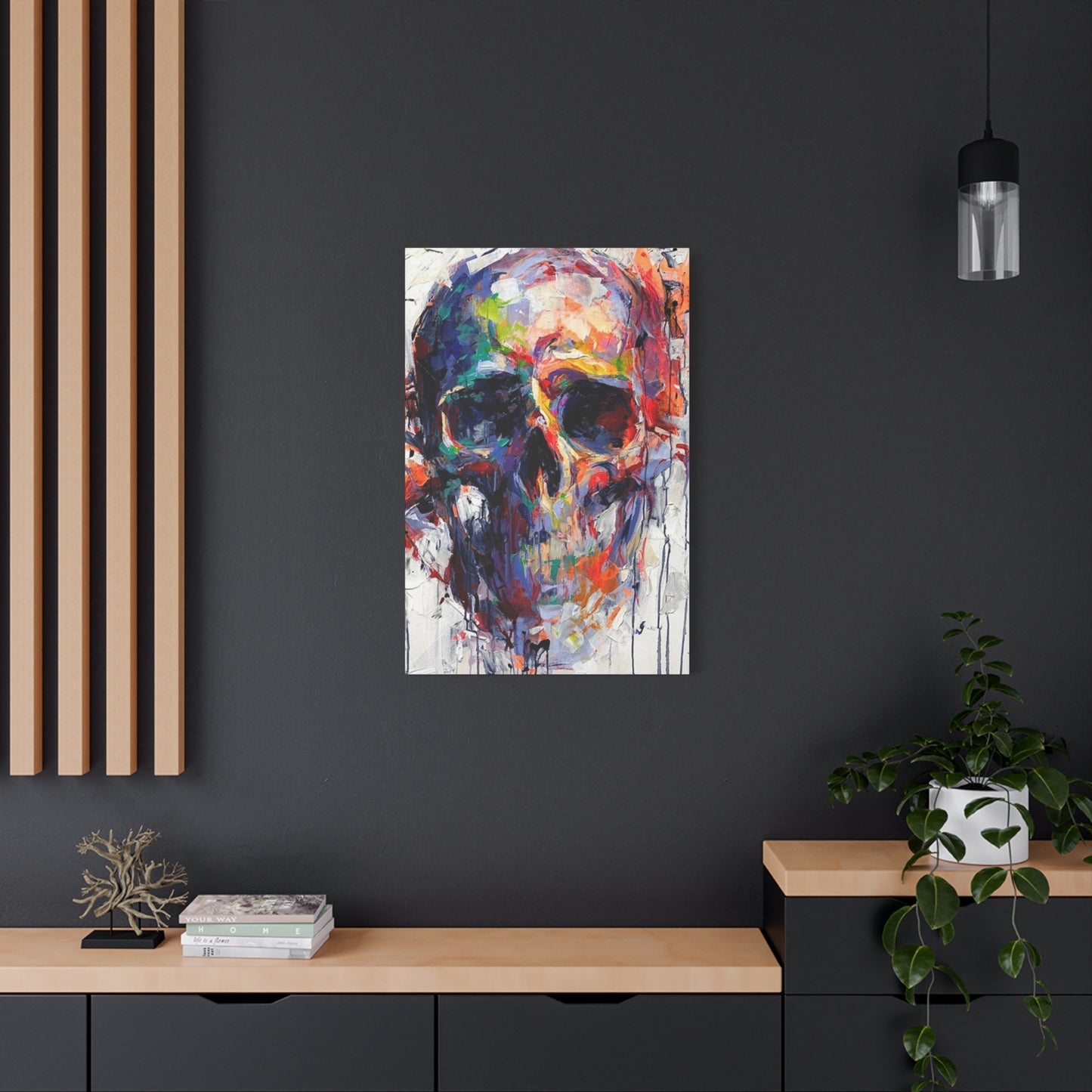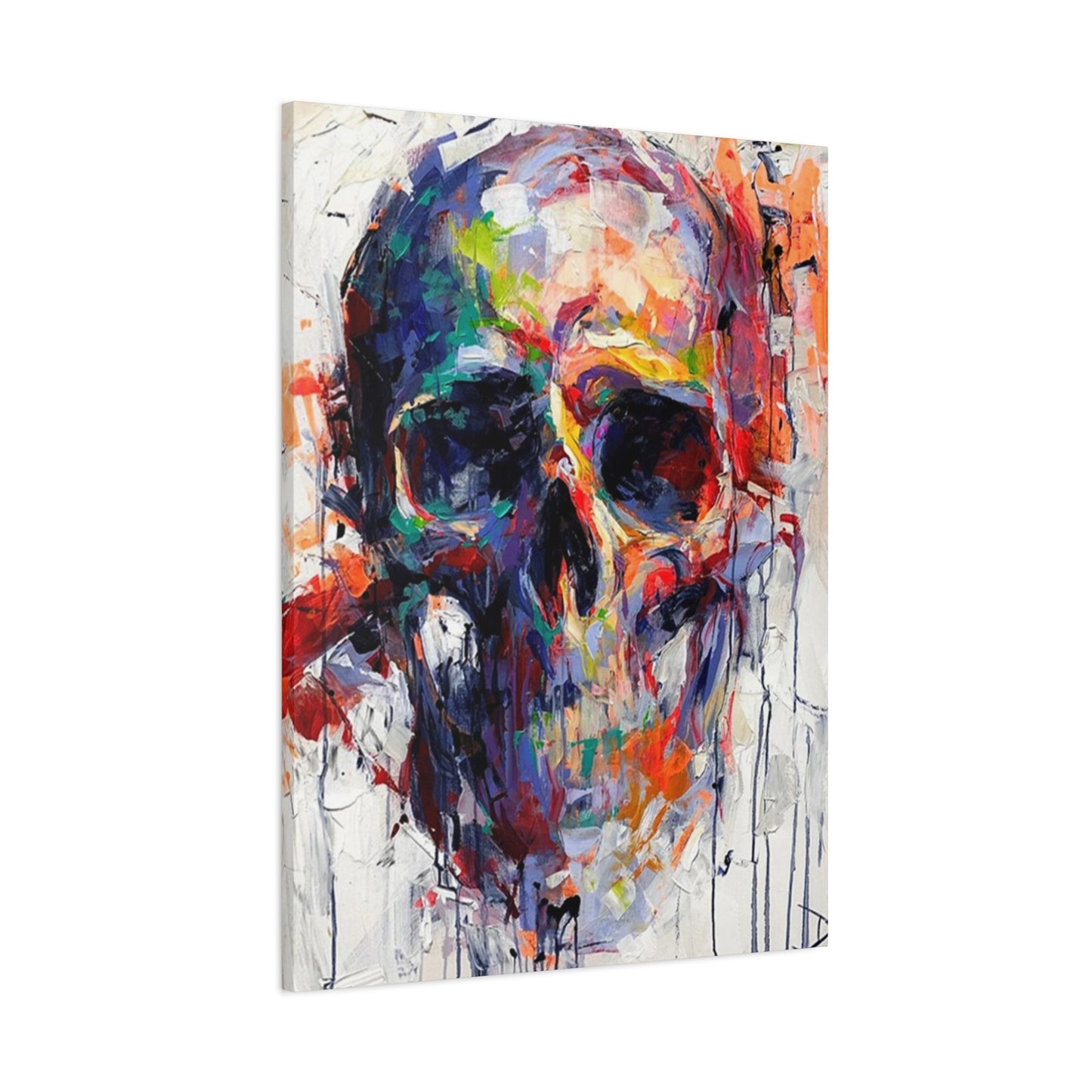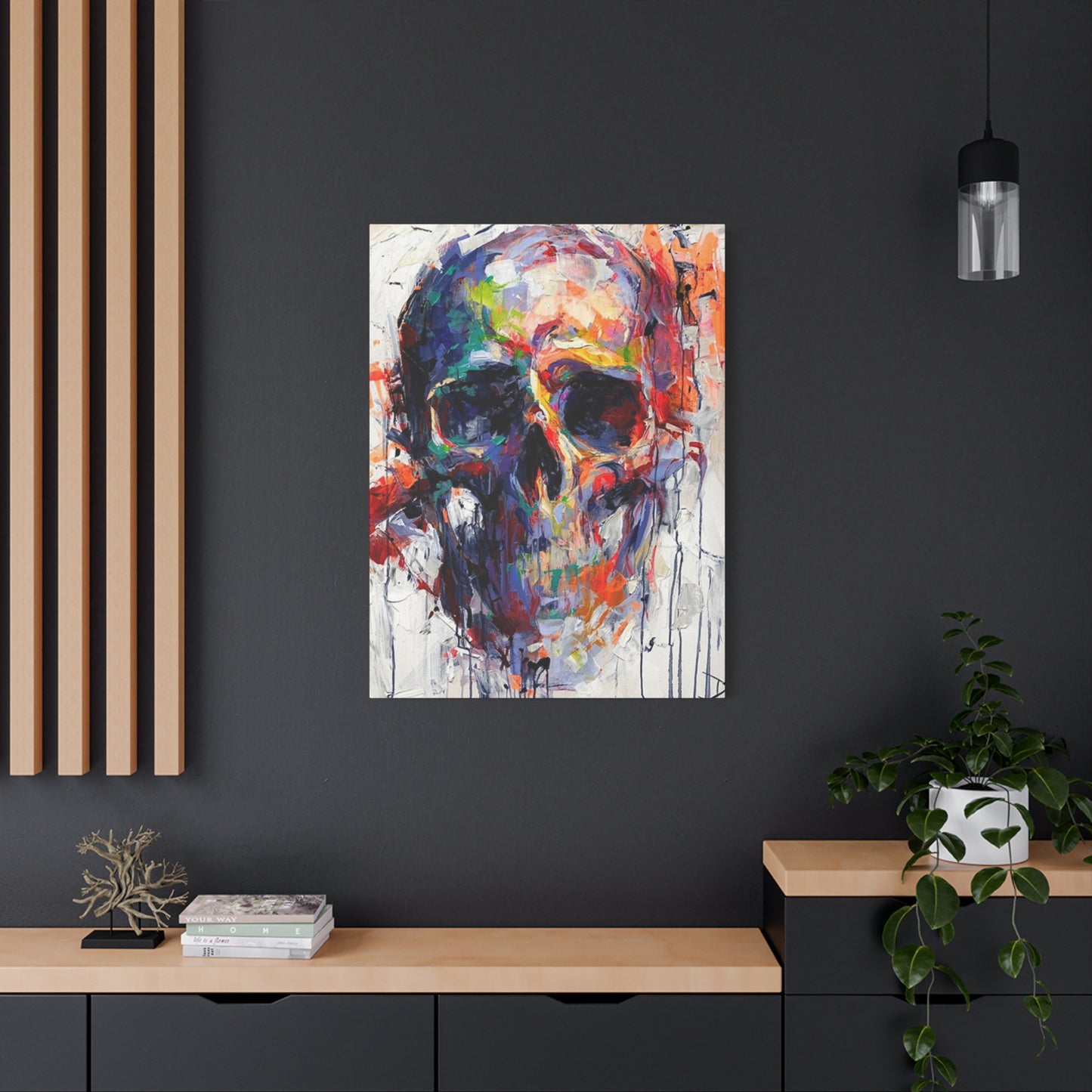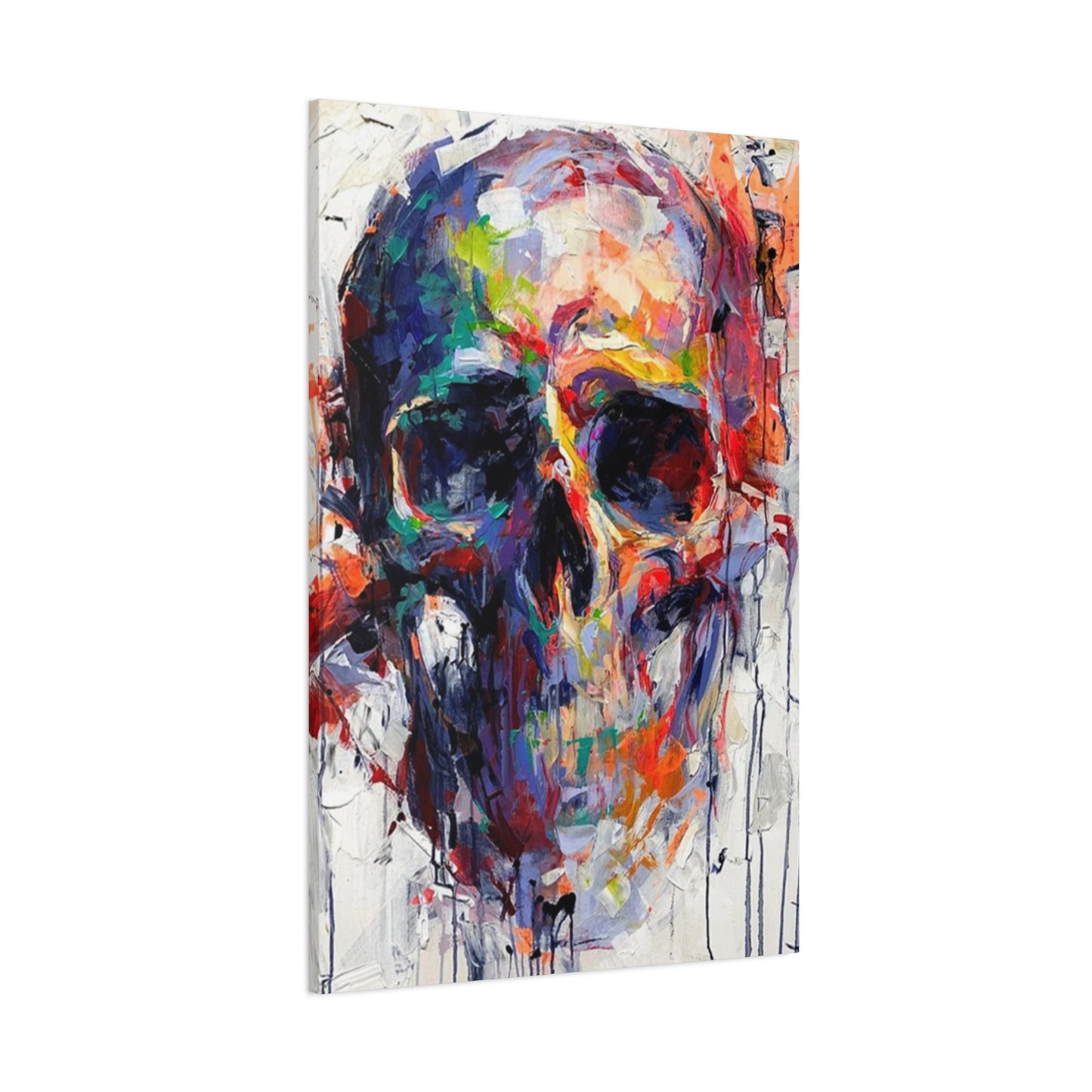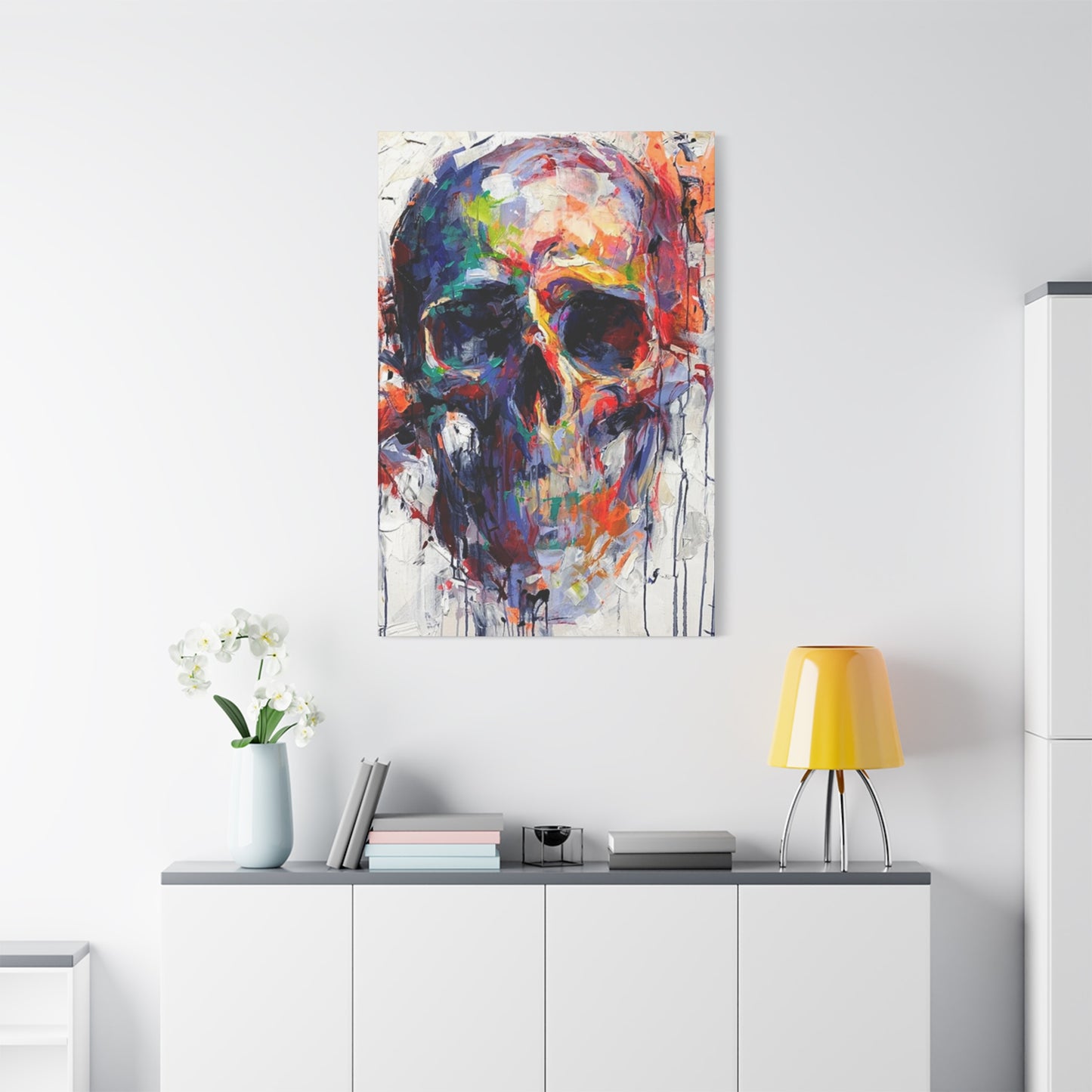Vibrant Skull Wall Art: A Comprehensive Guide to Colorful Canvas Creations
The world of contemporary home decoration has witnessed a remarkable evolution in recent years, with homeowners increasingly drawn to bold, expressive pieces that reflect their unique personalities and aesthetic preferences. Among the most captivating trends that have emerged is the growing popularity of colorful skull wall art, a genre that masterfully combines edgy symbolism with vibrant artistic expression. These striking canvas creations have transcended traditional boundaries, offering a fresh perspective on mortality-themed artwork while infusing living environments with energy, personality, and visual impact.
Colorful skull wall art represents more than just decorative pieces; they serve as powerful statements that challenge conventional notions of what constitutes appropriate home decoration. By incorporating bright, bold colors into traditionally dark imagery, these artworks create a fascinating juxtaposition that appeals to those seeking to express their individuality through their decorating choices. The artistic movement has gained tremendous momentum among homeowners who appreciate the balance between sophistication and rebellion that these pieces embody.
The appeal of skull-themed artwork extends beyond mere aesthetic considerations, tapping into deeper cultural and psychological elements that resonate with contemporary audiences. These pieces often serve as conversation starters, thought-provoking elements that encourage viewers to contemplate themes of life, death, and the beauty that can be found in unexpected places. The addition of vibrant colors transforms what might otherwise be considered morbid imagery into celebratory, life-affirming art that embraces both darkness and light.
The Evolution of Skull Art in Contemporary Culture
The historical significance of skull imagery in art can be traced back centuries, with various cultures utilizing skull motifs to represent different concepts ranging from mortality and spirituality to protection and celebration. In contemporary times, this ancient symbolism has undergone a remarkable transformation, evolving from its traditional somber associations to embrace a more colorful, optimistic interpretation that reflects modern artistic sensibilities.
Mexican Day of the Dead celebrations have played a pivotal role in reshaping perceptions of skull art, introducing the concept of colorful calaveras that celebrate life rather than mourning death. This cultural influence has permeated contemporary art movements, inspiring artists worldwide to reimagine skull imagery through vibrant color palettes that emphasize joy, celebration, and the beauty of existence. The result has been a revolutionary shift in how audiences perceive and appreciate skull-themed artwork.
Modern artists have embraced this cultural evolution, creating pieces that honor traditional symbolism while pushing creative boundaries through innovative color combinations and artistic techniques. These contemporary interpretations often incorporate elements of pop art, street art, and abstract expressionism, resulting in dynamic compositions that appeal to diverse aesthetic preferences. The transformation of skull art from dark, gothic imagery to bright, celebratory pieces represents a broader shift in contemporary culture toward embracing complexity and finding beauty in unexpected places.
The influence of digital art and graphic design has further accelerated the evolution of skull art, enabling artists to experiment with color gradients, digital effects, and complex layering techniques that were previously impossible with traditional media. This technological advancement has opened new possibilities for creative expression, allowing artists to create increasingly sophisticated and visually stunning pieces that push the boundaries of what skull art can achieve.
Exploring Color Psychology in Skull Wall Art
The incorporation of vibrant colors into skull imagery creates a fascinating study in color psychology and its impact on viewer perception and emotional response. Different color combinations can dramatically alter the mood and meaning of skull artwork, transforming potentially intimidating imagery into uplifting, energizing pieces that enhance rather than detract from living environments.
Warm colors such as reds, oranges, and yellows infuse skull art with energy, passion, and vitality, creating pieces that feel alive and dynamic rather than static and morbid. These color choices often evoke feelings of excitement, creativity, and confidence, making them ideal for homeowners seeking to create bold, statement-making focal points in their living areas. The psychological impact of warm-toned skull art can be particularly effective in social areas where energy and conversation are desired.
Cool colors including blues, purples, and greens offer a different emotional palette, creating skull art that feels more contemplative, mysterious, and sophisticated. These color choices can evoke feelings of calm, introspection, and spiritual connection, making them suitable for more private areas where reflection and relaxation are prioritized. The use of cool tones in skull art can create pieces that feel both edgy and serene, appealing to those who appreciate complexity in their decorative choices.
The strategic combination of complementary colors creates visual tension and excitement that draws viewers in and holds their attention. Artists skilled in color theory understand how to balance contrasting hues to create harmonious compositions that feel both dynamic and cohesive. This understanding is crucial when working with skull imagery, as the goal is often to create pieces that challenge expectations while remaining visually appealing and suitable for home display.
Monochromatic color schemes offer another approach to colorful skull art, utilizing variations of a single hue to create depth, dimension, and visual interest. This technique can be particularly effective for creating sophisticated pieces that make strong statements without overwhelming their surroundings. Monochromatic skull art often appeals to those who appreciate subtle sophistication and understated elegance in their decorative choices.
Canvas Printing Techniques for Skull Art
The technical aspects of creating high-quality skull wall art on canvas play a crucial role in determining the final impact and longevity of these decorative pieces. Modern printing technologies have revolutionized the ability to reproduce complex, colorful skull designs on canvas substrates, enabling artists and manufacturers to create pieces that rival traditional painted works in terms of visual quality and artistic impact.
High-resolution digital printing has become the standard for producing colorful skull canvas art, utilizing advanced inkjet technologies that can accurately reproduce subtle color gradations, fine details, and complex textures. These printing systems employ archival-quality inks that resist fading, ensuring that the vibrant colors that make skull art so appealing remain intact for years of display. The quality of digital printing has reached levels where the difference between printed and painted works becomes virtually indistinguishable to casual observers.
Canvas selection plays a critical role in the final quality of skull wall art, with different weave patterns, weights, and textures affecting both the appearance and durability of finished pieces. High-quality cotton canvas provides an ideal surface for skull art printing, offering excellent ink absorption, dimensional stability, and a professional appearance that enhances the perceived value of the artwork. The choice of canvas can significantly impact color saturation, detail reproduction, and the overall aesthetic appeal of the finished piece.
Stretching and framing techniques are essential considerations for skull wall art, as proper presentation can dramatically enhance the visual impact of these pieces while ensuring their longevity and professional appearance. Gallery-wrapped canvases that extend the artwork around the edges of the frame create a modern, sophisticated look that eliminates the need for additional framing while providing a clean, contemporary presentation suitable for various decorating styles.
Protective coatings and finishing techniques can further enhance the durability and appearance of skull canvas art, providing resistance to UV damage, moisture, and environmental pollutants that can degrade artwork over time. These protective measures are particularly important for colorful pieces, as the vibrant hues that define modern skull art are often more susceptible to environmental damage than traditional earth-tone artworks.
Popular Artistic Styles in Colorful Skull Art
The diversity of artistic styles available in colorful skull wall art reflects the broad appeal and creative potential of this genre, with artists drawing inspiration from numerous art movements and cultural traditions to create unique, compelling pieces. Each artistic style brings its own aesthetic sensibilities and emotional impact, offering collectors and homeowners a wide range of options to suit their personal tastes and decorating needs.
Pop art influences are particularly prominent in modern skull art, with artists employing bright, saturated colors and bold graphic elements reminiscent of works by Andy Warhol and Roy Lichtenstein. This style often incorporates commercial art techniques, comic book aesthetics, and consumer culture references, creating skull art that feels contemporary, accessible, and culturally relevant. Pop art skull pieces often appeal to younger demographics and those who appreciate the intersection of high art and popular culture.
Abstract expressionism offers another compelling approach to skull art, emphasizing emotional expression, gestural brushwork, and non-representational color use. These pieces often prioritize mood and feeling over literal representation, creating skull art that functions more as emotional landscape than anatomical study. Abstract expressionist skull art can be particularly effective for creating contemplative, sophisticated pieces that work well in professional and upscale residential environments.
Street art and graffiti influences have contributed significantly to the evolution of colorful skull art, bringing urban aesthetics, spray paint techniques, and counter-culture sensibilities into the mainstream art market. These pieces often incorporate text elements, stencil techniques, and layered compositions that reflect the energy and rebellious spirit of street art culture. Street art inspired skull pieces appeal to those who appreciate authentic, raw artistic expression and want to bring urban energy into their living environments.
Surrealist approaches to skull art create dreamlike, fantastical compositions that challenge reality and invite viewers into imaginary worlds where color, form, and meaning intersect in unexpected ways. These pieces often incorporate unexpected elements, impossible perspectives, and symbolic imagery that transforms skull motifs into gateways for imagination and contemplation. Surrealist skull art appeals to those who appreciate intellectual complexity and artistic innovation in their decorative choices.
Neo-traditional and contemporary realist approaches combine classical artistic techniques with modern color sensibilities, creating skull art that honors traditional craftsmanship while embracing contemporary aesthetic preferences. These pieces often demonstrate exceptional technical skill while incorporating bold color choices that make them suitable for modern homes. Neo-traditional skull art appeals to collectors who appreciate artistic excellence and want pieces that demonstrate both technical mastery and contemporary relevance.
Incorporating Skull Wall Art into Modern Home Decor
The successful integration of colorful skull wall art into contemporary home environments requires careful consideration of factors including color coordination, scale, placement, and the overall aesthetic vision of the living environment. When thoughtfully incorporated, these bold pieces can serve as powerful focal points that enhance rather than overpower their surroundings while reflecting the personality and artistic preferences of the homeowner.
Living room applications for skull wall art offer numerous opportunities for creating dramatic focal points that anchor seating arrangements and establish the overall tone of social areas. Large-scale pieces work particularly well above sofas, mantels, or entertainment centers, where they can command attention without competing with furniture or other decorative elements. The key to successful living room placement lies in ensuring that the artwork complements rather than clashes with existing color schemes and decorative themes.
Bedroom applications require more careful consideration, as these personal areas often benefit from artwork that promotes relaxation and reflection rather than high-energy stimulation. Softer color palettes and more contemplative skull art styles may be more appropriate for bedroom environments, though bold pieces can certainly work for those who find them personally meaningful or energizing. The scale of bedroom skull art should be proportionate to the room size and furniture arrangement to maintain visual balance.
Home office environments can benefit tremendously from carefully selected skull wall art, particularly pieces that inspire creativity, challenge conventional thinking, or reflect professional identity and personal values. The psychological impact of skull art can be particularly beneficial in creative work environments, where the symbolism of transformation and renewal can serve as daily inspiration for innovative thinking and problem-solving.
Dining room applications for skull wall art can create memorable, conversation-starting environments that enhance social gatherings and dinner parties. The key lies in selecting pieces that feel appropriate for food service areas while maintaining the bold, artistic impact that makes skull art so appealing. Color choices should complement table settings and dining furniture while creating an atmosphere that encourages lively conversation and memorable experiences.
Hallway and entrance applications offer opportunities to create striking first impressions that immediately communicate the homeowner's artistic sensibilities and design preferences. Skull wall art in these transitional areas can serve as preview of the home's overall aesthetic while providing visual interest in areas that might otherwise feel mundane or overlooked.
The Cultural Significance of Skull Imagery
The cultural implications of displaying skull imagery in contemporary homes extend far beyond mere aesthetic considerations, touching on themes of mortality, spirituality, rebellion, and personal expression that resonate deeply with modern audiences. Different cultures and religious traditions have varying perspectives on skull imagery, making it important for homeowners to consider these broader contexts when selecting and displaying skull wall art.
Western cultural interpretations of skull imagery have evolved significantly over the past several decades, moving from associations with death, danger, and rebellion toward more nuanced understandings that encompass themes of transformation, authenticity, and the celebration of life's complexity. This cultural shift has been influenced by various factors including globalization, changing religious perspectives, and the mainstream acceptance of alternative aesthetic preferences.
Mexican and Latin American cultural traditions have played a particularly influential role in reshaping contemporary perceptions of skull imagery, introducing concepts of celebration, remembrance, and spiritual connection that transform potentially negative associations into positive, life-affirming expressions. The Day of the Dead tradition, in particular, has contributed to a broader understanding of skulls as symbols of continuity, memory, and the interconnectedness of life and death.
Eastern philosophical and spiritual traditions offer additional perspectives on skull imagery, often viewing skulls as meditation objects that encourage contemplation of impermanence and the preciousness of life. These traditions have contributed to contemporary interpretations of skull art as tools for mindfulness, personal growth, and spiritual development rather than mere decorative objects.
The role of skull imagery in contemporary counter-culture movements continues to influence its perception and acceptance in mainstream society. Many individuals are drawn to skull art as a way of expressing non-conformity, individual identity, and resistance to conventional social expectations. This rebellious aspect can be particularly appealing to those who view their home decoration as an extension of their personal values and worldview.
Rock and roll, punk, and heavy metal music cultures have also contributed significantly to the mainstream acceptance of skull imagery, introducing it to broader audiences who might not otherwise be exposed to these artistic expressions. The association with music culture has helped normalize skull imagery while maintaining its edgy, rebellious connotations that appeal to many contemporary homeowners.
Color Combinations That Work Best with Skull Art
The selection of effective color combinations for skull wall art requires understanding of both color theory principles and the specific emotional and aesthetic goals of individual pieces and their intended environments. Different color relationships can dramatically alter the impact and appropriateness of skull artwork, making color selection one of the most critical decisions in both creating and selecting these pieces for home display.
Complementary color schemes create high-contrast, visually exciting skull art that demands attention and creates strong focal points in any environment. Classic complementary pairs such as red and green, blue and orange, or purple and yellow can create skull art with maximum visual impact while maintaining color harmony. These dramatic color relationships work particularly well for statement pieces intended to serve as primary focal points in large rooms or prominent display areas.
Analogous color schemes offer a more harmonious approach to skull art, utilizing colors that sit adjacent to each other on the color wheel to create pieces that feel cohesive and soothing despite their bold subject matter. These color relationships can be particularly effective for creating skull art that integrates more seamlessly with existing decor while still maintaining visual interest and artistic impact. Analogous schemes often work well in environments where multiple pieces need to coexist harmoniously.
Triadic color schemes employ three colors equally spaced around the color wheel, creating vibrant, dynamic compositions that feel energetic without being overwhelming. This approach to skull art can be particularly effective for creating pieces that feel contemporary and sophisticated while maintaining the bold, attention-grabbing qualities that make skull art so appealing. Triadic schemes offer excellent opportunities for creating complex, layered compositions with visual depth and interest.
Monochromatic color schemes utilize variations of a single hue to create sophisticated, elegant skull art that makes strong statements through form and contrast rather than color diversity. These pieces can be particularly effective for creating subtle, refined artwork that works well in professional environments or sophisticated home settings where bold color might feel inappropriate. Monochromatic skull art often appeals to those who appreciate minimalist aesthetics while still wanting edgy, meaningful artwork.
Split-complementary color schemes offer a sophisticated alternative to traditional complementary approaches, using a base color paired with the two colors adjacent to its complement on the color wheel. This approach creates skull art with strong visual impact while avoiding the sometimes overwhelming intensity of true complementary relationships. Split-complementary schemes can be particularly effective for creating complex, nuanced pieces that reward closer inspection and contemplation.
Canvas Sizes and Placement Considerations
The relationship between canvas size and room scale plays a crucial role in the successful integration of skull wall art into home environments, with proper proportions being essential for creating balanced, visually appealing displays that enhance rather than overwhelm their surroundings. Different room sizes, ceiling heights, and furniture arrangements require careful consideration when selecting appropriately scaled skull artwork.
Small-scale skull art, typically ranging from 8x10 inches to 16x20 inches, works exceptionally well for creating intimate displays, gallery walls, or accent pieces that complement larger artwork. These pieces can be particularly effective in powder rooms, small offices, or bedroom areas where subtle artistic statements are preferred over dramatic focal points. Small skull art also offers opportunities for collectors to display multiple pieces together, creating curated arrangements that tell broader artistic stories.
Medium-scale pieces, generally falling between 18x24 inches and 30x40 inches, offer versatility for most residential applications while providing sufficient visual presence to serve as focal points in appropriately sized rooms. These dimensions work particularly well for living rooms, bedrooms, and dining areas where the artwork needs to hold its own against furniture and other decorative elements without dominating the entire environment. Medium-scale skull art often represents the sweet spot for most homeowners seeking impactful yet manageable decorative pieces.
Large-scale skull wall art, typically 36x48 inches and above, creates dramatic statements that can transform entire rooms and serve as primary design elements around which other decorative choices revolve. These pieces require careful placement considerations, adequate wall area, and appropriate viewing distances to be effective. Large-scale skull art works best in rooms with high ceilings, substantial furniture, and sufficient visual breathing room to accommodate their imposing presence.
Oversized and mural-scale skull art represents the ultimate in dramatic home decoration, creating immersive environments that blur the line between artwork and architectural element. These pieces require significant commitment from homeowners and careful integration with architectural features, lighting, and furniture arrangements. Oversized skull art can be particularly effective in loft apartments, modern homes with substantial wall areas, or commercial environments where maximum impact is desired.
Multi-panel skull art offers unique opportunities for creating dynamic, scalable displays that can be customized to fit various wall configurations and room sizes. Triptych and multi-panel arrangements allow for creative flexibility while maintaining thematic coherence, enabling homeowners to create impactful displays that work within their specific architectural constraints. These arrangements can be particularly effective for long hallways, stairwells, or large walls that would be difficult to fill with single pieces.
Bold Art Choices in Home Decoration
The decision to incorporate bold, unconventional artwork such as colorful skull wall art into home environments reflects deeper psychological motivations related to identity expression, creativity, and the human need for stimulating, meaningful environments. Research in environmental psychology suggests that bold artistic choices can have significant impacts on mood, creativity, and overall life satisfaction, making the selection of dramatic artwork more than merely aesthetic decision-making.
Identity expression through bold artwork serves as a powerful form of non-verbal communication, allowing homeowners to share aspects of their personality, values, and worldview with visitors while creating environments that feel authentically reflective of their true selves. Skull wall art, with its associations with authenticity, mortality awareness, and non-conformity, can be particularly effective for individuals seeking to create homes that feel genuine and personally meaningful rather than following conventional decorating expectations.
The psychological impact of living with bold, thought-provoking artwork extends beyond mere aesthetic pleasure, potentially influencing daily mood, creative thinking, and overall life perspective. Exposure to challenging, meaningful imagery can stimulate intellectual engagement, encourage philosophical reflection, and provide daily reminders of important life themes such as authenticity, impermanence, and the importance of living fully. These psychological benefits can contribute to greater life satisfaction and personal growth over time.
Bold artistic choices can also serve as conversation starters and social catalysts, creating opportunities for meaningful interactions and deeper connections with visitors who share similar aesthetic sensibilities or philosophical perspectives. The presence of distinctive artwork such as skull wall art can help identify like-minded individuals while creating memorable, distinctive home environments that leave lasting impressions on guests.
The role of art in stress reduction and emotional regulation has been well-documented in psychological research, with meaningful, personally resonant artwork serving as sources of comfort, inspiration, and emotional stability. For individuals who find skull imagery meaningful or inspiring, these pieces can serve as daily reminders of important personal values or life philosophies, contributing to greater emotional well-being and psychological resilience.
Creative stimulation from bold artwork can have particularly significant benefits for individuals whose work or personal interests require innovative thinking, problem-solving, or artistic expression. The presence of challenging, unconventional artwork can help maintain creative mindset and encourage out-of-the-box thinking that benefits both professional and personal endeavors.
Maintenance and Longevity of Canvas Skull Art
Proper care and maintenance of colorful skull wall art ensures that these investments in home decoration retain their visual impact and artistic integrity for years of enjoyable display. Canvas artwork faces various environmental challenges including UV exposure, humidity fluctuations, dust accumulation, and potential physical damage, making proper maintenance practices essential for preserving the vibrant colors and crisp details that make skull art so appealing.
UV protection represents one of the most critical considerations for maintaining colorful skull art, as prolonged exposure to direct sunlight can cause significant color fading and deterioration over time. Ultraviolet radiation affects different pigments at varying rates, potentially creating uneven fading that dramatically alters the appearance and artistic impact of skull artwork. Strategic placement away from direct sunlight, the use of UV-filtering window treatments, or the application of protective UV-resistant coatings can significantly extend the lifespan of these decorative pieces.
Climate control plays an important role in canvas preservation, with stable temperature and humidity levels helping to prevent dimensional changes, canvas sagging, and the development of mold or mildew problems. Extreme temperature fluctuations can cause canvas materials to expand and contract, potentially leading to cracking, warping, or paint adhesion problems. Maintaining consistent indoor climate conditions through proper heating, cooling, and ventilation systems helps ensure the long-term stability of skull wall art.
Regular cleaning and dust removal helps maintain the visual clarity and color saturation that makes skull art so impactful, while also preventing the accumulation of pollutants and debris that can cause long-term damage. Gentle dusting with soft, lint-free cloths or specialized art cleaning tools can remove surface contaminants without risking damage to the artwork surface. For more thorough cleaning needs, professional art restoration services may be necessary to maintain the integrity of valuable pieces.
Proper hanging and support systems are essential for preventing physical damage and ensuring the long-term stability of skull canvas art. Heavy pieces require appropriate wall anchors and hanging hardware rated for their weight, while the use of proper hanging techniques can prevent stress concentration points that might lead to canvas damage over time. Professional installation may be advisable for valuable or particularly large pieces to ensure optimal support and security.
Storage considerations become important for skull art that may need to be temporarily removed from display due to home renovations, relocations, or seasonal rotation. Proper storage techniques including climate-controlled environments, protective wrapping, and appropriate positioning can prevent damage during periods when artwork is not on display. These considerations are particularly important for collectors who may own more skull art than they can simultaneously display.
Trends and Future Directions in Skull Wall Art
The evolution of colorful skull wall art continues to accelerate as artists, technology, and cultural influences combine to create new possibilities for creative expression and home decoration. Emerging trends in this artistic genre reflect broader shifts in contemporary culture, technological capabilities, and changing aesthetic preferences among consumers seeking distinctive, meaningful artwork for their living environments.
Digital art technologies are revolutionizing the creation and production of skull wall art, enabling artists to experiment with complex effects, layering techniques, and color manipulations that would be difficult or impossible to achieve through traditional media. Advanced software tools allow for precise color control, intricate detail work, and the seamless blending of photographic and illustrative elements that create increasingly sophisticated and visually stunning skull artwork. These technological advances are likely to continue expanding creative possibilities while making high-quality skull art more accessible to broader audiences.
Augmented reality and interactive technologies represent emerging frontiers in skull wall art, with some artists beginning to experiment with pieces that incorporate digital elements, changing displays, or interactive features that respond to viewer presence or environmental conditions. These innovations could potentially transform skull art from static decorative objects into dynamic, evolving artistic experiences that offer ongoing engagement and surprise for homeowners and visitors.
Sustainable and eco-friendly production methods are becoming increasingly important considerations in skull art creation, with growing consumer awareness of environmental issues driving demand for artwork produced using responsible materials and manufacturing processes. Artists and manufacturers are exploring alternative canvas materials, eco-friendly inks, and sustainable production techniques that reduce environmental impact while maintaining the quality and visual appeal that makes skull art desirable.
Customization and personalization trends are leading to increased demand for skull art that can be tailored to individual preferences, color schemes, and decorative needs. Advances in digital printing and online ordering systems make it increasingly feasible for consumers to request modifications to existing designs or commission entirely original pieces that perfectly match their specific requirements. This trend toward personalization reflects broader consumer preferences for unique, individually meaningful home decoration.
Cross-cultural fusion continues to influence skull art evolution, with artists drawing inspiration from diverse cultural traditions, artistic movements, and symbolic systems to create pieces that resonate with increasingly global audiences. This cultural mixing often results in innovative approaches to color, symbolism, and artistic technique that push the boundaries of what skull art can achieve while maintaining respect for the various traditions that inform contemporary work.
The integration of skull art with other artistic genres and decorative styles represents another significant trend, with artists and homeowners increasingly comfortable combining skull imagery with floral motifs, abstract elements, landscape features, and other seemingly contrasting artistic themes. This genre blending creates opportunities for more complex, nuanced artwork that appeals to broader audiences while maintaining the edgy, distinctive qualities that make skull art appealing.
Professional vs. DIY Skull Art Creation
The choice between purchasing professionally created skull wall art and attempting DIY creation involves numerous considerations including artistic skill, time investment, cost factors, and the desired quality of finished pieces. Each approach offers distinct advantages and challenges that make them suitable for different individuals and circumstances, with the best choice depending on personal priorities, capabilities, and artistic goals.
Professional skull art creation offers numerous advantages including access to advanced artistic training, specialized equipment, high-quality materials, and the experience necessary to create consistently excellent results. Professional artists understand color theory, composition principles, and technical execution in ways that enable them to create sophisticated, visually compelling pieces that effectively balance artistic merit with decorative functionality. The investment in professional artwork often results in pieces with greater longevity, artistic coherence, and resale value compared to amateur creations.
The quality control and consistency available through professional creation ensures that skull wall art meets high standards for color accuracy, detail reproduction, and overall finish quality. Professional printing facilities utilize calibrated equipment, quality control procedures, and archival materials that produce results superior to typical consumer-grade equipment and materials. This quality difference can be particularly important for skull art intended for prominent display or long-term enjoyment.
DIY skull art creation offers the appealing advantages of personal expression, creative satisfaction, and cost savings while allowing for complete control over artistic choices and creative direction. For individuals with artistic backgrounds or strong creative interests, the process of creating original skull art can be deeply rewarding and personally meaningful in ways that purchasing finished pieces cannot match. DIY creation also allows for perfect customization to specific color schemes, dimensions, and stylistic preferences.
The learning experience involved in DIY skull art creation can be valuable for personal development and artistic growth, providing opportunities to develop new skills, explore creative interests, and gain deeper appreciation for artistic processes and challenges. Even unsuccessful attempts at DIY skull art creation can provide valuable learning experiences and enhanced appreciation for professional artwork quality and artistic skill.
Cost considerations favor DIY approaches for budget-conscious individuals willing to invest time and effort in place of financial resources. While initial material costs and tool investments may be significant, the per-piece cost of DIY skull art can be substantially lower than professional alternatives, particularly for individuals interested in creating multiple pieces or ongoing artistic projects. However, these cost savings must be weighed against time investment, material waste, and the potential for unsatisfactory results.
Technical challenges in DIY skull art creation include color mixing and matching, proportion and scale management, detail execution, and finishing techniques that require significant skill and experience to master. Many individuals underestimate the complexity involved in creating professional-quality skull art, leading to disappointing results that fail to meet their decorative needs or artistic expectations. Realistic self-assessment of artistic capabilities is essential when considering DIY approaches to skull art creation.
The Role of Lighting in Displaying Skull Wall Art
Proper lighting plays a crucial role in maximizing the visual impact and artistic effectiveness of colorful skull wall art, with different lighting approaches capable of dramatically altering the appearance, mood, and aesthetic appeal of these pieces. The interaction between artificial lighting and artwork colors can enhance or diminish the intended artistic effect, making lighting considerations essential elements of successful skull art display.
Natural lighting offers unique advantages for displaying skull wall art, providing full-spectrum illumination that reveals the true colors and subtle details of these pieces while creating dynamic lighting conditions that change throughout the day. However, natural light also presents challenges including UV exposure risks, uneven illumination, and seasonal variations that must be carefully managed to prevent artwork damage while maintaining optimal viewing conditions.
Artificial lighting systems provide greater control over illumination quality, direction, and intensity while offering protection from UV exposure and weather-related variations. LED lighting technologies have revolutionized artwork illumination, providing excellent color reproduction, low heat generation, and energy efficiency while offering precise control over color temperature and beam characteristics. These advantages make LED systems ideal for skull art display applications.
Track lighting and adjustable spotlights offer excellent flexibility for skull art illumination, allowing for precise positioning and angle adjustment to minimize glare while maximizing color saturation and detail visibility. These systems work particularly well for gallery-style displays or situations where multiple pieces require individual lighting attention. The ability to adjust lighting angles and intensity enables fine-tuning of the viewing experience to achieve optimal artistic impact.
Ambient lighting considerations are important for creating appropriate context and mood around skull wall art displays, with general room illumination affecting how artwork appears and how viewers experience these pieces. Balanced lighting that provides adequate ambient illumination while highlighting artwork details creates more comfortable viewing conditions and better integration of skull art with overall room design and functionality.
Color temperature selection significantly impacts the appearance of colorful skull wall art, with cooler light temperatures typically enhancing blues and greens while warmer temperatures favor reds and yellows. Understanding these relationships enables homeowners to select lighting that enhances the most important colors in their skull art while creating desired mood and atmosphere. Variable color temperature systems offer the ultimate flexibility for optimizing lighting conditions for different pieces and occasions.
Accent lighting techniques can create dramatic effects that enhance the psychological and emotional impact of skull wall art while drawing viewer attention to important details or compositional elements. Backlighting, side lighting, and projected effects can add theatrical elements that transform skull art from simple decoration into immersive artistic experiences. These advanced lighting approaches require careful planning and professional installation to achieve desired results safely and effectively.
Building a Cohesive Collection of Skull Art
Developing a thoughtful, cohesive collection of skull wall art requires strategic planning, artistic vision, and careful attention to how individual pieces work together to create unified, impactful displays. Successful collections balance variety and consistency while reflecting the collector's personal aesthetic preferences and decorative goals, creating displays that feel intentional and professionally curated rather than random or haphazard.
Thematic consistency provides a foundation for cohesive skull art collections, with collectors often focusing on specific styles, color palettes, artistic movements, or cultural influences that create visual and conceptual connections between individual pieces. This thematic approach helps ensure that additions to the collection enhance rather than detract from existing pieces while maintaining a clear artistic vision that guides future acquisition decisions.
Color coordination plays a crucial role in creating visually harmonious skull art collections, with successful collectors often developing signature color palettes that unify diverse pieces while complementing their home decoration schemes. This approach requires understanding of color relationships and the ability to identify pieces that contribute to rather than compete with established color themes. Gradual palette evolution allows collections to grow and develop while maintaining visual coherence.
Scale and proportion considerations help create balanced displays where individual pieces support rather than overwhelm each other while creating appropriate visual hierarchy and flow. Successful collections often incorporate pieces of varying sizes that can be arranged in multiple configurations, providing flexibility for different display areas and changing decorative needs. Understanding how different scales work together enables collectors to create dynamic, visually interesting arrangements.
Artistic style diversity within cohesive parameters allows skull art collections to remain interesting and engaging while avoiding monotony or predictability. Collectors might focus on specific time periods, geographic regions, or artistic movements while allowing for stylistic variation that maintains visual interest and provides opportunities for discovery and appreciation. This balance between consistency and variety requires careful curation and artistic judgment.
Quality standards help ensure that skull art collections maintain high artistic and decorative value while providing long-term satisfaction and enjoyment. Establishing clear criteria for artistic merit, technical execution, and decorative effectiveness enables collectors to make confident acquisition decisions while avoiding pieces that might diminish overall collection quality. These standards often evolve as collectors develop greater expertise and refined aesthetic preferences.
Documentation and provenance considerations become increasingly important as skull art collections grow in size and value, with careful record-keeping helping to track acquisition details, artistic information, and maintenance history. This documentation can enhance collection value while providing useful information for insurance, security, and future disposition decisions. Digital photography and cataloging systems make collection management more efficient and accessible.
Display rotation strategies allow collectors to enjoy larger collections while preventing visual fatigue and maintaining fresh, dynamic home environments. Seasonal rotations, thematic displays, and periodic rearrangements can breathe new life into established collections while providing opportunities to rediscover forgotten pieces and create new viewing experiences. Storage considerations become important for pieces not currently on display.
Conclusion
Vibrant skull wall art is more than just a bold aesthetic choice—it's a powerful fusion of culture, symbolism, and artistic expression that can transform any room into a lively, thought-provoking space. These colorful canvas creations push the boundaries of traditional art by blending themes of life, death, and celebration into one compelling visual experience. Whether inspired by Día de los Muertos, modern pop art, or street-style graffiti, vibrant skull art captures attention and tells a story that resonates far beyond the surface.
What makes skull wall art truly stand out is its unique ability to combine contrast—life and mortality, vibrancy and darkness, tradition and rebellion—into a single cohesive piece. The skull, a symbol often associated with mortality, is reimagined through bright hues, intricate patterns, and bold strokes, turning it into a celebration of life, resilience, and identity. This paradox makes vibrant skull art incredibly versatile: it can add depth to modern interiors, color to industrial spaces, or cultural richness to eclectic rooms.
One of the great strengths of vibrant skull wall art is its adaptability across different styles and spaces. Whether you’re looking to create a focal point in a minimalist loft, add personality to a music studio, or give your home office an edge, there’s a version of skull art to suit your needs. From detailed hand-painted canvases to digitally designed prints bursting with neon shades, these artworks can be tailored to match your mood, interests, or décor theme.
Beyond its visual impact, skull art often carries personal or cultural significance. For many, especially those with Latin American heritage, skull imagery is tied to celebrations of ancestry, remembrance, and spiritual continuity. For others, it symbolizes individuality, transformation, or the embrace of life's fleeting nature. No matter the meaning you assign to it, vibrant skull wall art serves as a powerful conversation starter and an expressive extension of your personality.
Additionally, these works make meaningful and unconventional gifts. Whether for an art lover, a tattoo enthusiast, or someone who appreciates bold design, skull art offers something that’s both visually arresting and symbolically rich.
In conclusion, vibrant skull wall art is not just decoration—it’s an artistic statement packed with emotion, cultural depth, and dynamic color. It challenges conventions, celebrates life in all its complexity, and brings a striking visual energy to any environment. Whether you're curating a home gallery or just want to infuse a space with bold creativity, these colorful canvas creations are sure to leave a lasting impression.

















